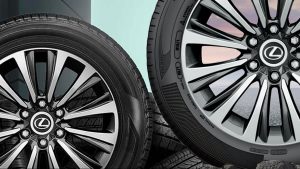You can optimize the performance of your luxury vehicle in a few different ways. One is by choosing tires that match your needs. You could replace aging tires with identical ones, but tires that better suit your needs could easily fit your budget. Here’s how to find the best tires for your Lexus vehicle.
When Should Tires Be Replaced?
Time and mileage are the key factors to consider when deciding whether to replace your tires. Tires degrade over time and with exposure to UV rays, extreme temperatures, and other hazards, making it wise to replace them after five years regardless of mileage. Tires with damage from road hazards need to be replaced right away, no matter how far they’ve driven.
Mileage guidance varies depending on driving habits, miles driven, and tire specifications. Some tires can reach 60,000 miles, depending on their specifications. Performance tires have a shorter life span in exchange for road-hugging ability.
Uniform Tire Quality Grade specifications for treadwear, traction, and temperature are stamped into the side of tires and provide specs indicating their life span. The higher the treadwear rating, the longer the projected tread life. Traction ratings show-stopping ability in wet conditions, with ratings from highest to lowest specified as AA, A, B, and C. Temperature ratings show durability in extreme heat, with the ratings from highest to lowest indicated as A, B, and C.
What Types of Tires Are Available?
When looking at replacement tires for your Lexus, you have four types to choose from:
Touring and All-Season
Touring and all-season tires perform well in dry, wet, and winter conditions and have a longer tread life than other tires. While they serve your car well throughout the year, they don’t give the stopping power and traction that snow tires can provide.
Performance
Performance tires give a better grip and higher speed ratings, offering better handling in both wet and dry conditions and a sporty feel. Performance tires have a shorter life and reduced quality of ride.
All-Terrain
All-terrain tires can tackle off-road conditions, are durable, and perform well in winter. The tread wears at an acceptable rate, but all-terrain options give less comfort and make more noise on the road.
Snow and Winter
Snow and winter tires are pliable and give good traction due to specialized rubber formulations designed for low temperatures. Tread patterns maximize handling and stopping ability on icy roads.
Tire size is another crucial factor to consider to ensure you have the performance and speedometer accuracy you need. Numbers and letters on the sidewall of a tire show key specifications:
- Type : P stands for passenger and appears on most tires.
- Width: Given in millimeters, this indicates the measurement from side to side.
- Height: This is the height-to-width ratio, or aspect ratio, with lower numbers indicating a faster response when turning.
- Construction: R is for radial, showing it’s constructed of rubber, fabric, steel, and polyester.
- Diameter: This indicates the rim size in inches.
- Load index number: The carrying capacity, with higher numbers indicating a higher capacity.
- Speed rating letter: This denotes the maximum speed and goes up to 186 mph for high-performance vehicles.
An example tire that fits a 2020 Lexus 350 is the P235-65-R18-106T.
Should I Replace My Tires With the Original Equipment?
It may be tempting to replace your tires with the original equipment your Lexus came out of the factory with. Original-style tires will work fine, but you may want to consider an alternative to those stock tires that were purchased in bulk by the manufacturer based on price and general specifications. Look at other brands and tires that may be better suited to your specific needs.
How Do I Choose the Best Tire?
Balance performance and budget when choosing replacement tires. For example, let’s look at a pre-owned Lexus RX 350 and consider the sample options for budget, mid-range, and higher-priced tires.
Budget
For 18-inch tires, budget-friendly offerings include the Laufenn S Fit AS, which gives a comfortable ride and a long life span. This model performs well in wet conditions but is only rated fair for snow and winter driving. For 20-inch tires, the Kumho Crugen HP71 gives a comfortable ride and a long life span. This model works well in light snow but isn’t recommended for heavy winter conditions.
Mid-Range
For 18-inch and 20-inch tires, mid-range offerings include the Continental CrossContact LX25, which is highly rated by consumers and gives an extended tread life. This tire has excellent ratings in wet conditions but is only rated fair for snow and winter driving. This mid-range tire is recommended because it balances price and performance.
Higher-Priced
For 18-inch and 20-inch tires, higher-priced offerings include the Goodyear Assurance WeatherReady model. This tire has a special rubber compound for winter driving but still offers a comfortable ride in all seasons, providing great performance all year round.
Tires Are a Key Maintenance Item
Neglecting necessary maintenance or ignoring warning signs that something is amiss can lead to being stranded or needing significant repairs to correct an issue that could have been an easy fix if caught early. Deferred maintenance can also lead to accidents. Tires need to be in good shape to maintain the safe operation of your vehicle. There are signs of potential problems you can often spot when driving and issues you can see when inspecting your car.
Neglected tires can lead to blowouts, poor steering, and reduced gas mileage. Watch for wobbly or uneven performance that could indicate worn tires. Be sure to have tires rotated as recommended by your owner’s manual and keep your tires properly inflated. Watch for wear like thinning tread or cracks, as well as bulges on the tread or sidewalls. Even new tires can have issues, including road damage or air leaks that can cause excess wear or flats.
Maximize tire life by maintaining the tire pressure that’s specified on the inside of your driver’s door, noting that the tire pressure stamped into your tire is a maximum pressure amount. Rotating tires every 5,000 to 7,000 miles helps maximize the life span and encourages even wear. Front tires tend to wear faster on front-wheel drive and all-wheel drive vehicles.
Lexus Tire Sale at Lexus Stevens Creek of San Jose, CA
If you’re considering options for the best tire for your Lexus, check with the maintenance experts at Lexus of Stevens Creek. We will help you find a balance between budget, comfort, and weather performance. During our October tire sale, you can purchase more tires for your money. For Lexus models, if you buy two tires, you save $50, and if you buy four tires, you save $100. This sale is the perfect opportunity for you to upgrade to top-quality tires. Contact our service and parts department for details.





